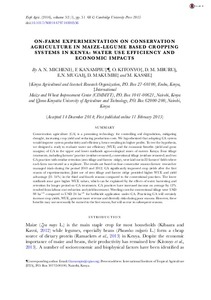| dc.contributor.author | Micheni, A.N. |
| dc.contributor.author | Kanampiu, F. |
| dc.contributor.author | Kitonyo, O. |
| dc.contributor.author | Mburu, D.M. |
| dc.contributor.author | Mugai, E.N. |
| dc.contributor.author | Makumbi, Dan |
| dc.contributor.author | Kassie, M. |
| dc.date.accessioned | 2019-12-04T10:57:22Z |
| dc.date.available | 2019-12-04T10:57:22Z |
| dc.date.issued | 2015-02-11 |
| dc.identifier.citation | Micheni, A., Kanampiu, F., Kitonyo, O., Mburu, D., Mugai, E., Makumbi, D. and Kassie, M. 2015. On-farm experimentation on conservation agriculture in maize-legume based cropping systems in Kenya: Water use efficiency and economic impacts. Experimental Agriculture |
| dc.identifier.issn | 0014-4797 |
| dc.identifier.uri | https://hdl.handle.net/20.500.12478/715 |
| dc.description.abstract | Conservation agriculture (CA) is a promising technology for controlling soil degradation, mitigating drought, increasing crop yield and reducing production costs. We hypothesized that adopting CA system would improve system productivity and efficiency, hence resulting in higher profits. To test the hypothesis, we designed a study to evaluate water use efficiency (WUE) and the economic benefits (yield and gross margins) of CA in the upper and lower midlands agro-ecological zones of eastern Kenya. Four tillage treatments, including farmers’ practice (residues removed), conventional tillage (residues removed) and two CA practices with residue retention (zero tillage and furrow–ridge), were laid out in 22 farmers’ fields where each farm was treated as a replicate. The results are based on four consecutive seasons farmer–researcher managed trials during the period 2010 and 2012. CA significantly improved crop yields after the first season of experimentation. Joint use of zero tillage and furrow–ridge provided higher WUE and yield advantage (25–34%) in the third and fourth seasons compared to the conventional practices. The lower midlands zone gave higher WUE values, which can be explained by the effects of water harvesting and retention for longer period on CA treatments. CA practices have increased income on average by 12% resulted from labour cost reduction and yield increment. Weeding costs for conventional tillage were USD 88 ha−1 compared to USD 24 ha−1 for herbicide application under CA. Practicing CA will certainly increase crop yields, WUE, generate more revenue and diversify risks during poor seasons. However, these benefits may not necessarily be earned in the first season, but will accrue in subsequent seasons. |
| dc.format.extent | 18p. |
| dc.language.iso | en |
| dc.subject | Legumes |
| dc.subject | Maize |
| dc.subject | Agriculture |
| dc.subject | Crops |
| dc.subject | Water |
| dc.title | On-farm experimentation on conservation agriculture in maize-legume based cropping systems in Kenya: Water use efficiency and economic impacts |
| dc.type | Journal Article |
| dc.description.version | Peer Review |
| cg.contributor.crp | Grain Legumes |
| cg.contributor.affiliation | International Institute of Tropical Agriculture |
| cg.contributor.affiliation | Kenya Agricultural and Livestock Research Organization |
| cg.contributor.affiliation | International Maize and Wheat Improvement Center |
| cg.contributor.affiliation | Jomo Kenyatta University of Agriculture and Technology |
| cg.coverage.region | Africa |
| cg.coverage.region | East Africa |
| cg.coverage.country | Kenya |
| cg.isijournal | ISI Journal |
| cg.authorship.types | CGIAR and developing country institute |
| cg.iitasubject | Maize |
| cg.iitasubject | Farming Systems |
| cg.iitasubject | Grain Legumes |
| cg.journal | Experimental Agriculture |
| cg.howpublished | Formally Published |
| cg.accessibilitystatus | Limited Access |
| local.dspaceid | 70332 |
| cg.targetaudience | Scientists |
| cg.identifier.doi | https://dx.doi.org/10.1017/s0014479714000556 |

